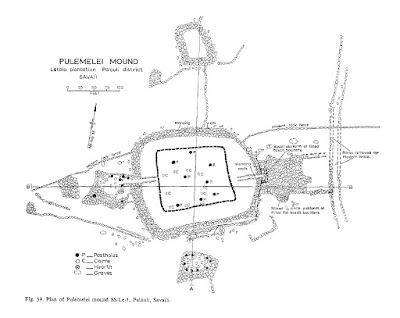Deep in the Samoan jungle, we’ll find one of the Pacific Islands’ best kept megalithic secrets. Pulemelei Mound, also knowns as the ‘Samoan Pyramid.’
 |
| Image Source: Samoa Observer |
The Pyramid in Samoa may not one of the more famous ones in the world, especially when compared to the Great Pyramids of Giza or the Pyramid of the Sun at Teotihuacan. However, there is something particularly intriguing about this one.
In a previous post about Lost Megalithic Civilisations of the Pacific, we discussed several of the Megalithic ruins scattered across the Pacific – each thousands of kilometers away from each other. Many of the Pacific Island Megaliths were quarried hundreds of kilometers from where they were built, sometimes even from other islands. This meant that rocks weighing in access of 50 tons needed to be transported by boat across the open ocean.
Too lazy to read? Watch the video here:
How Tall is Pulemelei Mound Pyramid in Samoa?
Standing 12 meters high, with a base of 3,900 square meters, the Pulemelei Mound is the largest megalithic monument in Samoa. The site is located about 2.7km inland, and 100 meters above sea level.
 |
| Source: Green and Davidson’s Archaeology in Western Samoa, 1969 |
Like many megaliths of the Pacific Ocean, Pulemelei Pyramid is constructed primarily of basalt rock. The pyramid has a rectangular base, consists of 3 levels, and a flat top – much like many of the Pyramids of the Americas.
Who built the Pulemelei Mound and Pyramid Complex and When?
 |
| Artist depiction of Pulemelei Mound, Green and Davidson’s Archaeology in Western Samoa, 1969 |
There are several different stories that surround the monument. However, it is unclear who exactly built the pyramid. Researchers have dated the site to have been built in stages, starting from 800 BC until 1,400 AD. It was eventually deserted around 1,800 AD.
Evidence of human activity throughout that time period indicates a thriving civilization in Samoa for at least a thousand years. Movement away from the structure was likely due to infrastructure and development led by European ‘explorers.’
According to experts, this new discovery proves that Samoa’s population before colonialism was far larger than previously thought.
Research & Mapping of Pulemelei Mound, Samoa
 |
| Mapping of the Mound in 1969, Green and Davidson’s Archaeology in Western Samoa |
The ruins of Pulemelei were first mapped in the 1960s. While no excavation was conducted, the mound itself was measured and mapped. In 1965, the area was mapped again. Some interesting features that were discovered included 10 smooth, circular stones at the top of the pyramid which the residents believe were used as seats.
In 1977, yet another survey was conducted. This was the first time that the area was fully mapped in detail. The survey uncovered over 3,000 man-made features, including housing, walls, walkways, and more.
 |
| 1977 Mapping of Pulemelei, Jennings et al 1982 Samoan Village Pattern |
LIDAR scanning in Samoa and the ‘Star Mounds’
The Pulemelei Mound is shaped into 8 separate sections or cogs. When viewed from above, it has a shape of a star – hence giving it the name ‘star mound.’
 |
| Source: Center for Samoan Studies |
In 2017, a LIDAR scan revealed something shocking. Aside from the area that was previously mapped, researchers uncovered an extensive network of housing and walkways, including over 80 star mounds. Most of these are located in difficult to reach areas, or have been buried under the island’s shrubbery over the years.
 |
| LIDAR scanning of Samoan Star Mounds. Source: Tagata Pasifika |
Based on the sheer number of the Star Mounds that were found, one must question what they were used for?
Pulemelei Mound for Sale?
Earlier this year (2020), the Pulemelei Mound was listed for sale in the newspaper Samoa Observer. The structure is located on a piece of land covering more than 1000 acres, the largest freehold property on Samoa, which was put on the market either as a single block or as nine separate lots.
The advert read: "The property's key features include rainforests, waterfalls, ocean views and ancient archaeological sites that would lend itself to a variety of endeavours such as hospitality, agribusiness, real estate development, research facilities.”
The sale prompted extensive protests from local residents as well as historians, who started an online petition to stop it.
In June 2020, the owners of the land announced that the site of the Pyramid would not be for sale.


0 comments:
Post a Comment